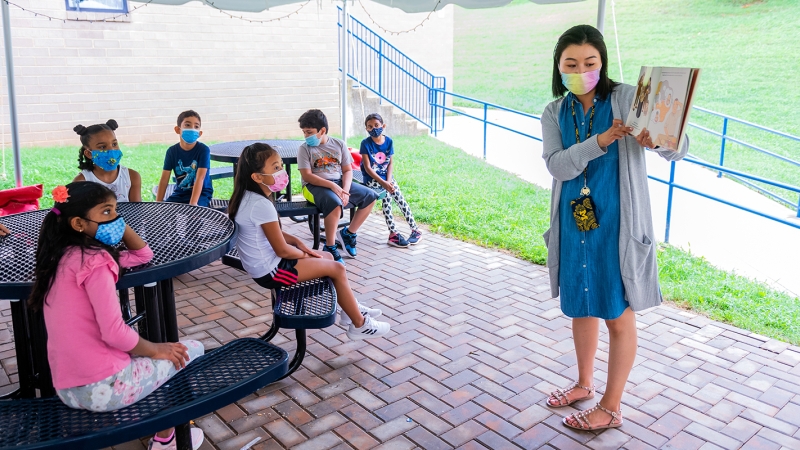
Fairfax County School Board Updates Policy to Guide Future Boundary Considerations
Community Engagement Remains Central to Any Future Adjustments
The Fairfax County School Board approved updates to the Boundary Policy (Policy 8130) at its July 18 Regular Public Meeting, completing a years-long comprehensive review of the policy for the first time in nearly four decades. The updates provide a clear roadmap for any future boundary adjustments to help ensure better student achievement through enhanced instructional quality, budget optimization, and strengthened student well-being.
The revised policy does not propose specific boundary changes, nor were specific boundaries considered during the policy review. Instead, the updates create a framework for the division superintendent to follow when considering any potential future adjustments, which must prioritize robust community engagement throughout the process.
According to the School Board’s updated policy, the division superintendent must conduct a comprehensive review of divisionwide boundaries every five years, in part, to minimize the need for future adjustments. When recommending changes, the division superintendent shall consider several criteria, including (in alphabetical order):
- Access to Programming: Ensure equitable access to programs and facilities across the school division and consider the impact on school programs and populations.
- Enrollment/Capacity: Use student enrollment projections to balance available capacity across the school division and maximize efficient and effective use of school facilities, per best practices for capacity utilization and program needs, while eliminating or preventing split feeders whenever possible.
- Proximity: Promote contiguous attendance zones and maintain neighborhood groupings (to include condominium and apartment complexes) to eliminate or prevent attendance islands (when a geographic area is assigned to a particular school boundary that is not adjacent to the rest of the school's boundary).
- Transportation: Provide for walking and busing safety, limit transportation times, and ensure efficient transportation routes with attendance areas.
Any permanent adjustment recommendations from the division superintendent will be informed by robust community engagement and must ultimately be approved by the School Board. Community engagement will include surveys of impacted communities and community meetings throughout the process.
“We take our fiduciary responsibility seriously. These revisions address long standing community concerns about our schools, including the use of temporary classrooms, overcrowding, facility renovation timelines, and transportation, to name a few,” said Fairfax County School Board Chair and Providence District Representative Karl Frisch. “This long overdue policy update will help ensure every student has access to our world-class instructional programs so they can achieve their full, unique, and limitless potential.”
Benefits of Policy Update
According to educational research reviewed by the FCPS Office of Research and Strategic Improvement (ORSI), sound boundary adjustment decisions may be linked to better student achievement through instructional quality, budget optimization, and enhanced student well-being.
Instructional Quality
A comprehensive review of boundaries can help provide every student with exceptional educational experiences. A clear roadmap for potential adjustments can:
- Provide ideal class sizes and teacher-to-student ratios, as over and under-enrollment in schools is better managed.
- Expand access to opportunities, facilities, and learning equipment and materials in a school that is not overcrowded.
- Decrease overcrowding and allow for a more balanced enrollment-to-space ratio, which can enable new and expanded program placement that is dependent on need instead of available space.
- Allow for reduced busing, commute time, and transportation costs.
Budget Optimization
A thoughtful review of boundaries can positively impact the school division's financial sustainability. A clear roadmap for potential adjustments can:
- Provide more timely and cost-effective results. While adding capacity to or renovating existing buildings is an attractive option for some, it is cost-prohibitive and time-consuming.
- Prioritize available funding for maintenance work, safety and security needs, and the most needed school renovations. It could also reduce the time schools wait between major renovation projects (currently more than 40 years).
- Maximize transportation routes, which can also reduce equipment costs and help alleviate driver shortages.
Student Well-Being
This work can support students’ physical and mental well-being, which is important to their educational experience.
Shorter Commutes and Positive Sleep Impact
- The updated policy could result in shorter bus/car commute times (a top priority in the 2021 parent/guardian survey). This could also reduce earlier mornings and later evenings for some students.
- If slight boundary adjustments are made on an established, consistent basis, larger and more disruptive adjustments can be avoided.
- Students could have the ability to stay in neighborhood schools AND receive their desired programs. This could also result in fewer students transferring and parents/caregivers having to provide transportation.
- Ultimately, this can positively affect the amount of sleep students get:
- According to the National Sleep Foundation, children ages 6 to 13 need between 9 and 11 hours of sleep, and teenagers need between 8 and 10 hours of sleep every night.
- Children who get insufficient sleep show reductions in motivation, engagement, concentration, and problem-solving skills, all of which influence student achievement and behavior in school.
Stronger Social Connections
- This work can reduce “split feeders” that divert students from remaining with a cohort of peers as they move on to high school.
- Split feeders are not uncommon in FCPS due to legacy boundaries, which result from development, new schools, and previous boundary changes.
- In the 2021 survey, parents and caregivers prioritized students' ability to stay with friends or in their community.
- Living close to a neighborhood school allows for stronger bonds between families and their school community.
- With a shorter commute, families find it easier to engage with the school, participate in school activities, attend conferences, and take part in volunteer opportunities.
- Families and schools can build stronger relationships and networks within the community to enhance the student educational experience.
Policy Review Timeline
The School Board began its public review of the Boundary Policy in 2018, which included information gathering and four public work sessions between 2018 and 2019. In 2019, the School Board directed the superintendent to hire experts to identify boundary policy best practices and engage the community. In 2021, MGT Consulting Group (MGT) held three public virtual community meetings to share information about the boundary policy review and collect community input. Later that year, MGT presented its report to the School Board at a public work session.
In February 2024, at a public School Board forum discussion, the Board voted to resume its review of the Boundary Policy. The Governance Committee then held public meetings in February, March, April (twice), May (twice), and June to discuss potential changes, ultimately concluding its work and sending a draft revised policy to the full School Board for consideration on June 18. On June 25, the School Board held a public work session to consider and discuss the draft revised policy. The draft revision was then posted on the School Board’s June 27 and July 11, Regular Public Meeting agendas as New Business for a scheduled vote at the July 18 Regular Public Meeting.
For more information, visit FCPS' School Boundary Adjustments webpage.
# # #








